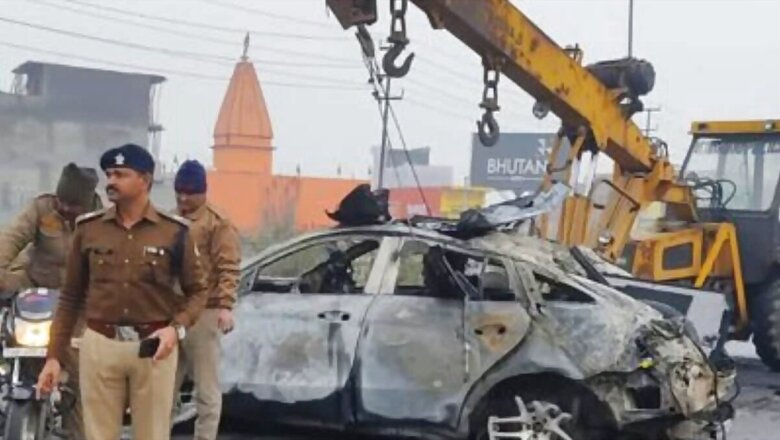
views
Road accidents are one of the biggest causes of deaths on Indian roads and the irony is they are avoidable. According to the report ‘Road Accidents in India 2021,’ a total of 4,12,432 road accidents were reported in the country in 2021, claiming 1,53,972 lives. At least one out of ten people killed on roads across the world are from India, according to the World Health Organisation (WHO). The government is working hard to control road accidents, with commitment and conviction.
Major Causes of Deaths in Road Accidents
Overspeeding emerged as the leading cause of on-road fatalities. According to a report published in Car&Bike, overspeeding was the cause of nearly 60 percent of accidents in India. A similar conclusion was reached in a study conducted over a year by the Central Road Research Institute (CRRI) with the assistance of John Hopkins University and the Delhi government. Other contributory reasons are noncompliance with seat belts and helmets, along with poor pedestrian infrastructure and behaviour.
In 2021, 1239 people died in road accidents in Delhi alone, with pedestrians accounting for more than 40 percent of those killed.
Government Efforts in Raising Awareness
The Ministry of Road Transport and Highways (MoRTH) held Road Safety Week from January 11-17, 2023, as part of Swachhata Pakhwada, with the goal of raising road safety awareness among all citizens. Speaking as part of the “Sadak Suraksha Abhiyan” outreach campaign, Union Minister for Road Transport and Highways, Nitin Gadkari, stated that all stakeholders must work together to reduce road accidents by half by the end of 2025.
Improving Road Infrastructure
Aside from increasing public awareness about road safety, the government must supplement its efforts by improving and maintaining existing infrastructure. When people become accustomed to negotiating non-functional unmanned traffic lights at a traffic intersection for example, their seriousness about obeying the next one wanes, unless there is a police presence or a camera watching. Similarly, faded or non-existent lanes force vehicle riders to improvise, and this behaviour persists even when lanes are clearly marked.
Other challenges faced by pedestrians and motorists alike include the lack of properly marked pedestrian crossings with traffic lights, as well as footpaths on some of the busier roads, which contributes to the high rate of pedestrian deaths. Authorities can hardly demand compliance with safety features when they are simply absent in some places. It also reflects on the commitment of the government to implementing the road safety program holistically.
Punishment Versus Deterrence
The Motor Vehicles Act contains stringent provisions for challans for overspeeding, not wearing seatbelts or helmets, and jumping red lights, among many other violations, in order to promote road safety. In the calendar year 2021, 1.98 crore challans worth Rs 1,898.73 crore were issued across the country for traffic violations, with 13 lakh issued in Delhi alone. Over 40 lakh challans worth Rs 417 crore were issued in the first quarter of 2022 for traffic violations across the country. Increasing the amount of challan and making it prohibitively expensive is frequently suggested as a more effective measure.
Challans are necessary, but do they help to reduce accidents on their own? Someone who receives a challan is undoubtedly wiser, but the person who has not been served one is the issue here. And, of course, some people believe they can’t be unlucky twice. The psychological issue is that the person who breaks the rule takes a risk because he knows the chances of being caught are slim. So to speak, there is insufficient deterrence.
The deterrence theory of punishment holds that punishment serves to deter crime and proposes harsh punishments as an example and warning to others, causing them to refrain from committing a crime. The problem with deterrence theory is that it assumes that humans are rational actors who consider the consequences of their actions before acting, which is often not the case.
According to research into the role of punishment in creating deterrence, the certainty of being caught is a far more powerful deterrent than the punishment. People, it is believed, commit crimes, or violations in this case, based on the likelihood of being caught rather than the severity of the punishment. A strong deterrent in the form of the certainty of being caught may, therefore, reduce road violations more effectively than increasing the severity quotient of challans.
Ways to Create Credible Deterrence
What is the mechanism of deterrence? A weapon of deterrence, for example, would be considered a deterrent only if it was displayed. A hidden weapon would be a killing weapon. Similarly, tools for ensuring compliance on the road, such as a traffic cop or a camera, should be widely publicised and displayed. There is no point in concealing the traffic or speed camera in order to fine people after the violative act because the violation itself could have caused an accident, which is to be avoided and for which the camera was installed in the first place.
A popular navigation service in the United Kingdom warns users of the approaching camera, which is legal. As a result, people slow down, stay in their lanes, and do not run red lights, among other things. Of course, if the rule is still broken, the penalty is severe. Thus, the true purpose of installing the camera is met. It may be worthwhile for the government to include similar warnings as an optional feature in various navigation services in India. Most people behave well when they are being watched.
The traffic police strategy could also be modified to make their presence known wherever they are, rather than concealing it in order to pounce on violators. The goal should be to prevent violations in the first place. Police presence in full view, wherever deemed necessary, will deter violations far more effectively than punishing the violator after the act of violation.
The Way Forward
The government’s efforts to raise awareness about road safety are an effective strategy for reducing traffic fatalities and injuries. Aside from raising awareness, the government must examine critical aspects that will ensure the success of these efforts. Proper infrastructure maintenance, such as functional traffic lights, clearly marked lanes, automated methods to ensure compliance and a preventive approach than punitive will undoubtedly yield positive results.
The author is a retired fighter pilot, former Air Advisor at High Commission of India, London and Director General (Inspection & Safety), Indian Air Force. Views expressed are personal.
Read all the Latest Opinions here



















Comments
0 comment